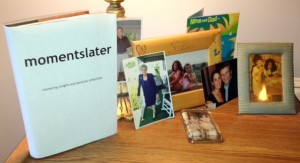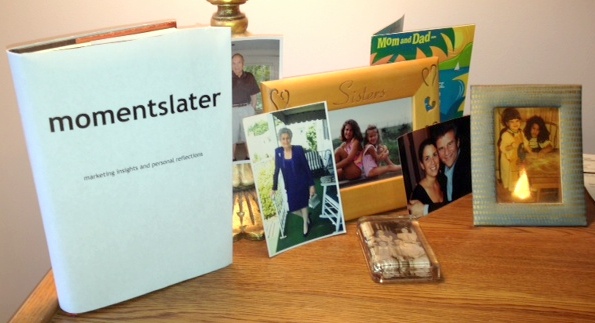 |
| Visualizing writing a marketing book for 2013 |
Since it is the end of the year, I thought I would share one of my favorite marketing ideas. It is something I have deployed in almost every job I have had since I was a teenager putting away paint cans at Karlin’s Paint Store in Springfield, New Jersey and carried through to my current global marketing position today.
I have decided that in 2013 that one of my personal goals is to publish a marketing book that is written for inexperienced business people looking for marketing advice. My goal is to share stories about my experiences and to extract a key lesson from each story. A physical book (or e-book) will provide me with a new platform, beyond my blog, to mentor and teach about marketing to interested entrepreneurial students, small business owners and others. It is something I have never done so it is a perfect challenge for me.
Making it Real
To help encourage, motivate and focus my effort, I have created a mock book (cover and all) that I keep on my desk at home. It allows me to see the end product and to help me keep my eye on my prize. This mock book is a physical representation of something I want to achieve in 2013. It also reminds me that it is never enough to just create something (a product, a brochure, a book, etc.) As I hold this mock book in my hand, it forces me to think how I will market it to my target audience.
Some people call this visioning where you create a board (on Pinterest or the real world) of your wishes and desires. I like something I can get my arms around as I imagine what it will feel like to complete this effort.
At times it may be hard to make a physical representation of your goal, but a little creativity can help. As a teenager, when I worked in the paint store, I was tasked with reorganizing all the paint cans, brushes and stock in the basement. It was a huge job that was going to take much of the summer. I took one small area of this space, and made it immaculate. Everything in order and properly rotated. I took a Polaroid of the finished section and I kept it with me to motivate me what the entire job would look like when I finished. That picture represented the goal and by holding it my hands, it somehow made it achievable.
You can comment on this blog, send an email to me at JeffreyLynnSlater@gmail.com or as the Car Talk guys on NPR like to say, write your question on the back of a $20 bill and mail it to me. Thanks for traveling along with me on this journey.







Thank you again for the excellent advice and inspiration! I have a couple big, yet intangible, career/life goals for 2013 and look forward to approaching them in this way.
Happy 2013!
Michael
Michael, I appreciate your note and comments. Wishing you a healthy, successful and fulfilling New Year.
It wasn’t at my first job stocking shelves at Carchman Pharmacy on Millburn Ave. but rather at a sign shop in Durham where I learned a similarly impactful lesson about how to “get ‘er done.” Up until then I had viewed the idea of taking a break as something you did in the middle of a task to pace yourself. What my boss helped me to understand was that any sizable project already was broken down into many discrete parts, so although taking a breather was fine it was more efficient to stick it out until getting to one of those natural demarcations. Once I recognized the truth to this, it became easier to “power through” and keep at any given task with the idea that the respite would come before long anyway, and once it did the amount of work left ahead would be lesser, on top of which I would have earned the rest more so having accomplished something.
I’ve applied this mentality to every project I’ve worked on since that college job, and I’ve been much more effective than I would have otherwise. One of the main reasons for this is that I no longer get caught up in managing the inevitable complications of a start/stop work flow that keeps me from turning my intellect fully towards improvements to the process and the bettering of the over all effort. These “pre-planned” stoppage points provide an excellent opportunity to triage the tasks left to be done and account for new information, both things which are invaluable when managing marketing campaigns, or anything else for that matter.
As it turns out, there has been a very nice side-benefit to this way of doing things, which is that I regularly get compliments on my “excellent work ethic.” No false modesty here, I put in the time for sure, but I don’t believe that I necessarily work any harder than others do so much as when I interact with others over the course of time it is typically at a point where I’ve just finished something and am somewhat relaxed as a result. To those people who are in the midst of doing something, I figure it must seem like I get more done as a result.
Perceptions aside (which is no small thing where the client is the one drawing conclusions), I think taking this approach of getting an entire phase of the job completed, then looking at what remains to be done at a point where nothing is hanging out there unfinished and competing for your attention, means fewer chances for streamlining the effort are missed. They say the best quarterbacks are the ones that both keep the play alive and keep looking down field because what started as a planned short yardage gain might turn out to be a touchdown if only the passer realizes his man is open deep.
Ken, is that Millburn Avenue in New Jersey you are referencing? My favorite place to eat lunch, in all of the world, is Millburn Deli. But that is a blog for another day.
Thanks so much for your comment and interesting perspective. Stopping mid-project to take account of where you are and what you have achieved is a great strategy to check in with yourself to make sure things haven’t changed in an important way. I’m a big believer in thinking about a project backwards to make sure I really want to do it and to be cautious about what it is I will do with the finished project. It reminds me if it is worth the work. I hate to work on off-strategic efforts.
Wishing you good health and happiness in 2013.
That place is good and all, but you must never have eaten at Town Hall Deli on South Orange Ave. in The Village. Their signature Sloppy Joe is amazing, and Sonny’s Bagels up the street from there is my gold standard. Cheers from one Jersey Boy to another, and keep the good posts coming.
Working backwards to achieve the goal reminds of advice given by the man who created the Marlboro Man campaign and Guerrilla Marketing. He’s rather famous now, but sadly I cannot remember his name. Anyway, he wrote an article once recommending that people approach marketing the same way a good golfer tees off. You aim for the cup. But, you cannot see the cup? How can you aim for something you cannot see? Well, I am no golfer – let alone a good one. But, from what I understand, they work backwards from the cup. Some even visualize the golf swing as being successful BEFORE they actually swing the club. You see, I always thought a hole-in-one was a “happy accident.” Turns out, in most cases, it is actually the result of a good design.